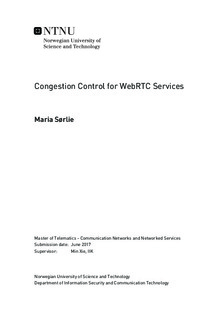Congestion Control for WebRTC Services
Master thesis
Permanent lenke
http://hdl.handle.net/11250/2456126Utgivelsesdato
2017Metadata
Vis full innførselSamlinger
Sammendrag
Multimedia applications are increasing in popularity and using a big partof the Internet traffic. Web Real-Time Communication (WebRTC) isnew technology which allows peer-to-peer communication in the browserswithout any extra plugins. The focus of this report is to determine theimportance of congestion control for the WebRTC-services.
In this thesis, I developed my own WebRTC-application. The developingprocess contained research about features, protocols, and technologiesused. The final service was fully developed with audio and video featuresfor multimedia conversations. In addition, instant messaging was addedfor assurance in case of communication problems.
Further, the developed WebRTC service were to conduct experiments.The Experiments conducted where divided into two phases. First phasetested the WebRTc service itself, to ensure the service was workingproperly. Second phase consisted of 10 participants using the developedservice and give session feedback. I collected both session statistic dataand giving feedback from each session.
The experiments focused on the Quality of Service (QoS) and the userperceived Quality of Experience (QoE), by looking at sent and receivedbits and packets, packet loss rate and jitter values. I got an indicationof the QoS and if high values had an affect on how the user experiencedthe session. Results show that it was the audio interruptions were mostheavily influenced by poor QoS.
Congestion control is a mechanism needed for transportation of dataacross the Internet, to promote fair usage and prevent congestion collapse.After looking at results from the experiments, a congestion control maybe needed. I have evaluated two WebRTC congestion controls, GoogleCongestion Control (GCC) and Network Assisted Dynamic Adaption(NADA), to fully understand how they operate.
The findings from experiments and the evaluation indicate a needfor a congestion control, and both GCC and NADA are found to beappropriate congestion controllers.
Keywords WebRTC, Quality of Service, Quality of Experience, congestioncontrol, GCC, NADA, experiments.
